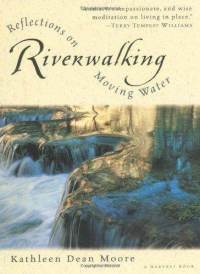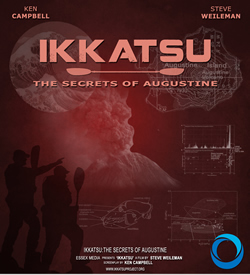
Riverwalking
I am not used to seeing the river like this. It rolls like muscle, looking heavy and fierce, covering the places that I know and changing the look of everything else to the point that I almost forget where I am. It is February, cruel and gray. The buds have not yet made their appearance on the trees, the bare alder and big-leaf maple. Blackberry brambles lie snarled above the shore, almost leafless at this time of year, thick coils of stalks with hard, re-curved thorns like barbed wire glistening in the wet. It has been raining steadily for several days now. Snow is falling at the higher elevations but the mild temperatures here in the low country are melting it away with a will. And it all comes through here, this place, this once-quiet bend in the river that looks today more like a raging and unstoppable torrent.
“No man ever steps in the same river twice, for it’s not the same river and he’s not the same man.” Heraclitus made his famous observation almost three thousand years ago; it seems, however, that this is a lesson each of us must learn for ourselves about our own personal rivers of time. Whether we are wading through the shallows or seeking excitement in its more turbulent waters, any river is an example of constant change and of time’s passing. As I stand here in the mud along the shore, I can see the hydraulic bending of the water’s surface in several places that give away the locations of unseen rocks. The last time I was here those rocks were the high points of little islands in the stream, reef edges in the run of the river. Now they are hidden, wrapped in water, observable only through inference.
In her book, Riverwalking: Reflections on Moving Water, writer Kathleen Dean Moore shares stories of the rivers she has known, their twists and turns, their dark overhung shorelines and sunny riffles serving as telling counterpoints to her own condition. These are twenty essays that explore the way that time moves, the love that a mother has for her child, all the desperate necessities that make up a life, much in the way that a river follows its serpentine course to the sea. “I have come to believe that all essays walk in rivers,” says Moore. It is her point that the answers to life’s most basic questions about meaning and existence come to us on the waters of time and experience, moving at a different pace in a region just out of sight, sometimes only to be seen indirectly.
In the essay entitled, “Salish River,” Moore offers an inside look at the death of her father and the questions that it raised in her own mind. She comes to the river as to her therapist, to find the answers that she needs, to get some sort of reassurance that the decisions she has made in her life have been the best ones possible. There is an intimacy here, not only in the details about her father’s life and death, but also in the way that she listens to the language of the river, even when meaning can be hard to understand. “Answers come from rivers only reluctantly. You have to build understanding out of small moments.”
At the edge of my river the rain has stopped, at least for the moment. There are several large rocks right at the edge of the water, along a sheltered back eddy on the inside hook of the waterway. The river laps at their bases but everything above that point is covered in a thick layer of moss. I bend down to get a closer look. At first, I see two different types of moss dominating the field: a short dark variety and a somewhat taller and lighter one. My eyes and my mind are arranging this duality into patterns on the rocks, tiny forests of green, living things, holding onto life in a difficult place. I get closer, the tip of my nose just barely above the surface. From there, I can see other plants mixed in, not just the two I’d seen before. There are strands of root that I follow back up to a collection of miniscule plants that look a bit like microscopic ivy, with a smudge of red on each little leaf, nothing I can remember seeing before. I wonder how many things there are like these plants, how many unseen life forms surrounding me that I don’t know about, that would seem utterly improbable if I had to try to explain them. It takes time to see the small things.
“Winter Creek,” the fourth essay in the book, stands as Moore’s homage to the simplest of outdoor activities. “I wish to speak a word for the art of poking around,” is the way she begins, then proceeding to tell of the many joys that have come from simply pottering about and making observations about the world around her. Her decidedly non-linear style of highly detailed traveling identifies her as one of this tribe of wanderers; the way she revels in the descriptions of those who, “… have seeds in their socks and rocks in their pockets,” enumerates her values perfectly. There is a holiness to this way of experiencing nature and Moore ties the value of this slower path to it’s being, “…a guaranteed way to learn… Everything interesting is complicated. Since truth is in the details, seekers of the truth should look for it there.”
A few paces down the bank from the moss-covered rocks, I come across animal tracks in the mud along the shore. I see the unmistakable prints of raccoon, delicate fingers so human-like in the way they work, in the way that the hands always inform the mind. There are smaller prints as well, a mouse maybe, a weaving trail of light stutter-steps along the level ground and up into the weeds. Birds, too, have left their footprints behind. Although the river is roaring past just a few feet away, this serene backwater tells the stories of the many animals that are all around me, other forms of river life that are incredibly important to me, whether I can see them there or not.
The topics that Moore explores in the book include not only the death of her father, but also the sense of loss that comes to every mother when a child leaves the protection and comfort of home. In “The Willamette,” she gives an inside account of how a family can go through its cycles, its ups and downs, how it is the nature of this life that changes come and that even sadness has its lessons to share. She examines the homing instinct in people and asks the question that all mothers want to have the answer for: “What will draw our own children back home?” In all this, the river is never far away with its powers to heal and to console, and Moore shows the reader this connection when she describes her breaking down, a moment in time when she lay, “… face down on the round rocks and cried until the steam from my lungs seeped down into the dried mud and algae, and the hot breath of the river rose steaming and sweet around my face.” The river understands.
Moore has said that when she was assembling the various essays that eventually come together in Riverwalking, she had no preconceived sense of the order the stories would take. Her method of organization consisted of first trying them one way, then another, then moving them around again until she found a sequencing that seemed to resonate. She rearranged them in front of her, thinking through not just chronology and message, but the way that each piece blended into the next, switching mood and intensity in a way that made sense. They were ultimately divided into five sections of four essays each and while there is a discernible but inconsistent geographical pattern to the way they are grouped together, it is the stories themselves that pull the reader forward, each one standing alone yet somehow connected to those on either side with a flow that can’t help but be reminiscent of a river.
I look around for one last time before I go, taking in the power and the volume of the river at my feet and the leafless branches scratching the low gray sky above me. It will not always be like this, of course. The rain will stop and the water level will fall. What is raging and dangerous now will become green and benign once again, perhaps by June, more likely July. The river will change by the time I get back to this spot. Of course, by the time I get back, I will no longer be this person that is here right now; the river and I both will have changed in many ways. It is as certain as life itself, that life is certain change. Says Moore, “There is nothing to do, then, but follow the day through to the end, bracing against the next drop.”










